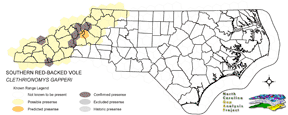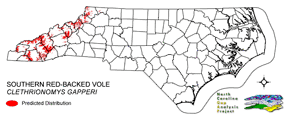
| Taxa: |
| Order: |
| Family: |
| Mammalia |
| Rodentia |
| Muridae |
| NatureServe Global Rank: |
| NatureServe State (NC) Rank: |
| G5 |
| S4 |
| Federal Status: |
| NC State Status: |
| --- |
| --- |


| Land Unit |
| US Fish & Wildlife Service |
| US Forest Service |
| US National Park Service |
| US Department of Defense |
| NC State Parks |
| NC University System |
| NC Wildlife Res. Com. |
| NC Forest Service |
| NC Div. of Coastal Mgmt. |
| Local Governments |
| Non-Governmental Org. |
| Other Public Lands |
| Private Lands |
| GAP Status 1-2 |
| All Protected Lands |
| Statewide |
| Hectares |
| 0.00 |
| 122,411.97 |
| 0.00 |
| 61,558.47 |
| 806.49 |
| 49.50 |
| 1,617.84 |
| 2.34 |
| 0.00 |
| 4,444.56 |
| 4,948.74 |
| 0.00 |
| 158,644.98 |
| 85,086.45 |
| 195,765.84 |
| 354,484.89 |
| Acres |
| 0.00 |
| 302,486.51 |
| 0.00 |
| 152,114.26 |
| 1,992.88 |
| 122.32 |
| 3,997.77 |
| 17.35 |
| 0.00 |
| 10,982.74 |
| 12,228.60 |
| 0.00 |
| 392,020.21 |
| 210,264.72 |
| 483,759.40 |
| 875,962.63 |
| % of Dist. on |
| Prot. Lands |
| 0.0 % |
| 62.5 % |
| 0.0 % |
| 31.4 % |
| 0.4 % |
| < 0.1 % |
| 0.8 % |
| < 0.1 % |
| 0.0 % |
| 2.5 % |
| 2.5 % |
| 0.0 % |
| 0.0 % |
| 43.5 % |
| ----- |
| ----- |
| % of Dist. on |
| All Lands |
| 0.0 % |
| 34.5 % |
| 0.0 % |
| 17.4 % |
| 0.2 % |
| < 0.1 % |
| 0.5 % |
| < 0.1 % |
| 0.0 % |
| 1.3 % |
| 1.4 % |
| 0.0 % |
| 44.8 % |
| 24.0 % |
| ----- |
| ----- |
|
This species is quite abundant in cool, moist montane forests of the southern Appalachians, typically at elevations above 3400ft (Linzey and Linzey 1971). High elevation montane boreal forests of coniferous spruce and fir trees and the ecotone areas where these boreal forests mix with northern hardwood (birch, beech and maple trees) forests are the haunts of this species (Whitaker and Hamilton 1998). Upper-mid elevation hemlock forests and bogs, where sphagnum moss dominates as ground cover, are also used to a great extent (Brown 1997, Whitaker and Hamilton 1998). Moss-covered rocky or heavy log-fall areas, or damp slopes, densely shaded with evergreen shrubs (rhododendron) within these forest types appear to contain the highest population densities. They are also found in grassy woodlands and grassy mountain meadows and heath balds (Linzey and Linzey 1971, Webster et al. 1985). At lower-mid mountain elevations, some bogs and other cool wet forested situations, such as rich cove forests and densely vegetated creeks, are occasionally used as well (Linzey and Linzey 1971, Lee et al. 1982). It has also been reported in cut areas with brush piles and debris (Whitaker and Hamilton 1998). They construct nests of grass, leaves and moss in shallow burrows or rock crevices (Lowman 1975). NATURE SERVE GLOBAL HABITAT COMMENTS: Prefers cool, moist deciduous, coniferous, or mixed forests, especially areas with large amount of ground cover. Regarded as an ecological indicator of old-growth conditions in the Rocky Mountains. Also uses second-growth areas. Mossy logs and tree roots in coniferous forests are optimal. Often on rock outcrops in some areas (e.g., Virginia). Often associated with abandoned stone walls (fences) in the northeastern U.S. In Pennsylvania, abundance increased with forest fragmentation (Yahner 1992). Nests under logs, stumps and roots. Unlike MICROTUS, doesn't dig tunnels, but uses the burrows of moles and other small mammals. |
| Code | Name | Description | NC Natural Heritage Program Equivalent |
| 230 | Piedmont Mesic Forest | American Beech - Red Oak - White Oak Forests. | Mesic Mixed Hardwood |
| 384 | Piedmont/Mountain Mixed Bottomland Hardwood Forests | Includes temporarily to seasonally forests dominated by hardwood species. Hardwoods include sweetgum, red maple, sycamore which co-occur in a mosaic of bottomland and levee positions. Includes alluvial hardwood forests in the mountains. Hemlock and white pine may occur as inclusions, but are generally mapped separately. | Piedmont/Mountain Alluvial Forest, Piedmont/Mountain Levee Forest |
| 517 | Hemlock Floodplain Forest | Alluvial forest with hemlock and/or white pine in mountains and western piedmont. Hydrology is generally temporarily to seasonally flooded. | Canada Hemlock Forest |
| 521 | Spruce/Fir Forest | High Elevation Frazer-Fir - Red Spruce, Red Spruce and Red-Spruce-Yellow Birch Forests. Tree densities included here include both woodland to forest density. Highly intermixed with Northern Hardwoods, Grassy Balds, and Shrub Balds. | Red Spruce--Fraser Fir Forest, Fraser Fir Forest |
| 522 | Northern Hardwoods | High Elevation forests including yellow birch, American beech, and yellow buckeye. Includes forests with Hemlock and Yellow Birch. | Northern Hardwoods Forest, Boulderfield Forest |
| 523 | Grassy Bald | High Elevation grassy balds including Pennsylvania sedge, mountain oatgrass, as well as shrubby areas dominated by Alleghany and smooth blackberry. | Grassy Bald |
| 524 | Shrub Bald | Variable phenologies, predominantly evergreen balds with rhododendon and Mountain laurels. Deciduous shrubs including green alder and Alleghany and smooth blackberry are included as well. Red Oak - Chestnut Oak Woodlands may be included in cases where the density of the woodland species is low and the shrub component is dense. | Heath Bald |
| 525 | Appalachian Oak Forest | A variety of oak forest types including Black, White, Scarlet Oaks in dry to mesic situations. Includes forests historically co-dominated by American Chestnut. | High Elevation Red Oak Forest, Montane White Oak Forest |
| 526 | Appalachian Cove Forest | Mixed Mesophytic forests of the mountains. Includes tuliptree, basswood, yellow buckeye and surgar maple. This class is mapped to include cove forests dominated or co-dominated by hemlock. | Rich Cove Forest, Acidic Cove Forest |
| 527 | Appalachian Hemlock | Upland hemlock forests of the moutains region. Vary from side slopes to steep slope positions. | Canada Hemlock Forest |
| 533 | Appalachian Swamp Forest | Evergreen and deciduous forests with saturated hydrologies. This class may contain a variety of trees species, including hemlock - red maple, pitch pine, and white pine forests. | Swamp Forest-Bog Complex, Southern Appalachian Bog, Southern Appalachian Fen |
| 534 | Appalachian Wet Shrubland/ Herbaceous | Saturated shrubs and herbaceous vegetation. Often mapped as an inclusion in Appalachian Swamp Forest. | Southern Appalachian Bog, Southern Appalachian Fen |
|
Blair, W.F. 1941. Same data on home ranges and general life history of the short-tailed shrew, redbacked mouse and wood-land jumping mouse in northern Michigan. Am. Midl. Nat. 25(3):681-685.
Merritt, J.F. and J.M. Merritt. 1978. Population ecology and energy relationships of Clethrionomys gapperi in a Colorado subalpine forest. J. Mamm. 59(3):576-598. Merritt, J.F. 1981. Clethrionomys gapperi. Am. Soc. Mamm.,Mammalian Species No. 146. 9 pp. Maser, C., and Z. Maser. 1988. Mycophagy of red-backed voles, CLETHRIONOMYS CALIFORNICUS and C. GAPPERI. Great Basin Nat. 48:269-273. Jones, J. K., Jr., et al. 1992. Revised checklist of North American mammals north of Mexico, 1991. Occas. Pap. Mus., Texas Tech Univ. (146):1-23. Butsch, R.S. 1954. The life history and ecology of the red-backed vole Clethrionyms gapperi Vigors in Minnesota. Univ. Michigan, unpubl. Ph.D. dissertation, 161 pp. Lowman, G. E. 1975. A survey of endangered, threatened, rare, status-undetermined, peripheral, unique mammals of thes.e. National Forests and Grasslands. USDA Forest Service Contract 38-2601. 121 pp. Yahner, R. H. 1992. Dynamics of a small mammal community in a fragmented forest. Am. Midl. Nat. 127:381-391. Wilson, D. E., and D. M. Reeder (editors). 1993. Mammal Species of the World:a Taxonomic and Geographic Reference. Second Edition. Smithsonian Institution Press, Washington, DC. xviii + 1206 pp. Brown, L. N. 1997. A guide to the mammals of the southeastern United States. University of Tennessee Press, Knoxville. xiv + 236 pp. Whitaker, J.O. Jr. and W.J. Hamilton, Jr. 1998. Mammals of the eastern United States. Cornell Univ. Press, Ithaca, New York. 583 pp. Lee, D. S., L. B. Funderburg Jr., and M. K. Clark. 1982. A distributional survey of North Carolina mammals. Occasional Papers of the North Carolina Biological Survey, No. 1982-10. North Carolina State. Mus. Nat. Hist., Raleigh, North Carolina. 72 pp. Linzey, Alicia V., & Donald W. Linzey. 1971. Mammals of the Great Smoky Mountains National Park. The University of Ten- nessee Press, Knoxville, Tennessee. 114 p. Banfield, A.W.F. 1974. The mammals of Canada. University of Toronto Press, Toronto. Godin, A.J. 1977. Wild Mammals of New England. Johns Hopkins University Press, Baltimore. 304 pp. Hamilton, William J., Jr., and John O. Whitaker, Jr. 1979. Mammals of the eastern United States. Cornell Univ. Press, Ithaca, New York. 346 pp. Hall, E. R. 1981. The Mammals of North America. Second edition. 2 Volumes. John Wiley and Sons, New York, New York. Baker, Rollin H. 1983. Michigan mammals. Michigan State University Press. 642 pp. Webster, W. D., J. F. Parnell and W. C. Biggs Jr. 1985. Mammals of the Carolinas, Virginia, and Maryland. The University of North Carolina Press, Chapel Hill, NC. Nordyke, K. A., and S. W. Buskirk. 1991. Southern red-backed vole, CLETHRIONOMYS GAPPERI, populations in relation to stand succession and old-growth character in the central Rocky Mountains. Can. Field-Nat. 105:330-334. |
For more information please contact them at:
NC-GAP Analysis Project
Dept. of Zoology, NCSU
Campus Box 7617
Raleigh, NC 27695-7617
(919) 513-2853
www.basic.ncsu.edu/ncgap